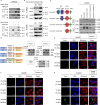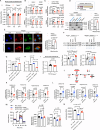NOTCH1 mitochondria localization during heart development promotes mitochondrial metabolism and the endothelial-to-mesenchymal transition in mice
- PMID: 39550366
- PMCID: PMC11569218
- DOI: 10.1038/s41467-024-54407-7
NOTCH1 mitochondria localization during heart development promotes mitochondrial metabolism and the endothelial-to-mesenchymal transition in mice
Abstract
Notch signaling activation drives an endothelial-to-mesenchymal transition (EndMT) critical for heart development, although evidence suggests that the reprogramming of endothelial cell metabolism can regulate endothelial function independent of canonical cell signaling. Herein, we investigated the crosstalk between Notch signaling and metabolic reprogramming in the EndMT process. Biochemically, we find that the NOTCH1 intracellular domain (NICD1) localizes to endothelial cell mitochondria, where it interacts with and activates the complex to enhance mitochondrial metabolism. Targeting NICD1 to mitochondria induces more EndMT compared with wild-type NICD1, and small molecule activation of PDH during pregnancy improves the phenotype in a mouse model of congenital heart defect. A NOTCH1 mutation observed in non-syndromic tetralogy of Fallot patients decreases NICD1 mitochondrial localization and subsequent PDH activity in heart tissues. Altogether, our findings demonstrate NICD1 enrichment in mitochondria of the developing mouse heart, which induces EndMT by activating PDH and subsequently improving mitochondrial metabolism.
© 2024. The Author(s).
Conflict of interest statement
Figures






References
-
- McKellar, S. H. et al. Novel NOTCH1 mutations in patients with bicuspid aortic valve disease and thoracic aortic aneurysms. J. Thorac. Cardiovasc Surg.134, 290–296 (2007). - PubMed
-
- Garg, V. et al. Mutations in NOTCH1 cause aortic valve disease. Nature437, 270–274 (2005). - PubMed
-
- Andersson, E. R., Sandberg, R. & Lendahl, U. Notch signaling: simplicity in design, versatility in function. Development138, 3593–3612 (2011). - PubMed
Publication types
MeSH terms
Substances
Grants and funding
LinkOut - more resources
Full Text Sources
Molecular Biology Databases

